ENGINEERING FIRM SELECTS, INSTALLS AQUATHERM PP-R PIPE FOR THERMAL-STORAGE SYSTEM
Getting trained and certified on aquatherm pipe installation and doing the work themselves saved $85,000—while also meeting a tight timeline.
The Challenge
OCI needed a cooling system piping solution that would meet their stringent cost and time requirements.
The Solution
Getting trained and certified on aquatherm pipe installation and doing the work themselves saved $85,000—while also meeting a tight timeline.
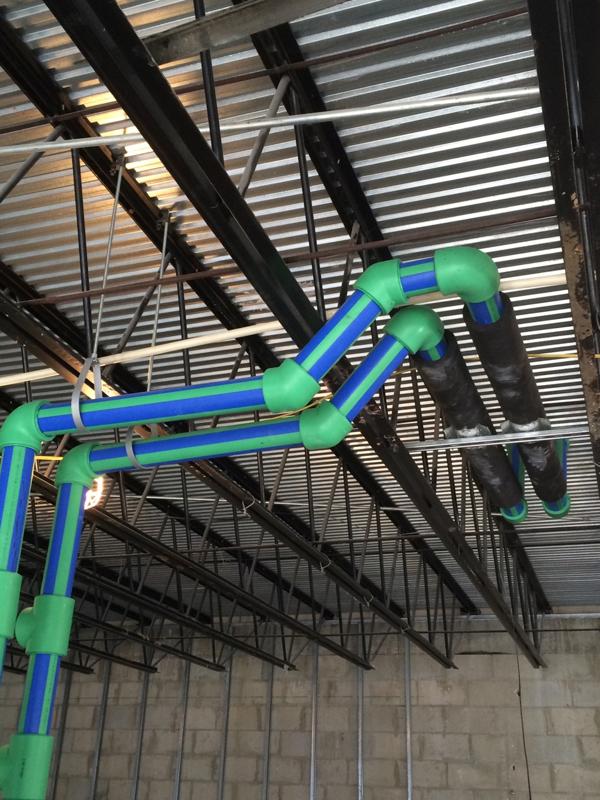 If you want something done right—or on time and on budget—sometimes you just have to do it yourself. The professional engineers at OCI Associates Inc., a consulting engineering firm in Maitland, FL, had been looking to invest in a facility of their own for many years; when the opportunity arose, they bought a three-story, 12,000-sq-ft building in a good location.
If you want something done right—or on time and on budget—sometimes you just have to do it yourself. The professional engineers at OCI Associates Inc., a consulting engineering firm in Maitland, FL, had been looking to invest in a facility of their own for many years; when the opportunity arose, they bought a three-story, 12,000-sq-ft building in a good location.
The structure was an older facility with antiquated and inefficient systems that clearly required renovations before the firm could move in. The firm bought the chosen building during summer 2014, but had to be out of the old office prior to January 2015 when their lease officially was going to expire.
The engineering team specifically designed the building’s updates with future customers in mind. “We wanted to be able to showcase to our clients the possibilities of what could be specified in their buildings,” said Director of Mechanical Engineering Jason Smith, P.E.
Smith and President Amir Kazeminia, P.E., put the mechanical plans out for bid. Several mechanical contractors came back with prices of roughly $250,000—more than double what the engineering firm had budgeted. However, the engineers weren’t interested in scaling back their design, so they began to examine the bids.
“There was quite a bit of money in the overhead, profit and labor that seemed to be driving the bids up,” Smith said. Finally, “we were sitting around one night brainstorming ways to save the design intent and said, ‘What if we do it ourselves?’”
Kazeminia, who also has his mechanical-contracting license, set up a contracting firm. “In order to save our design, we had to self-perform our installation,” Smith said.
As part of the structure’s modernizations, the engineers wanted to create a chilled-water system that included a thermal-energy-storage (TES) 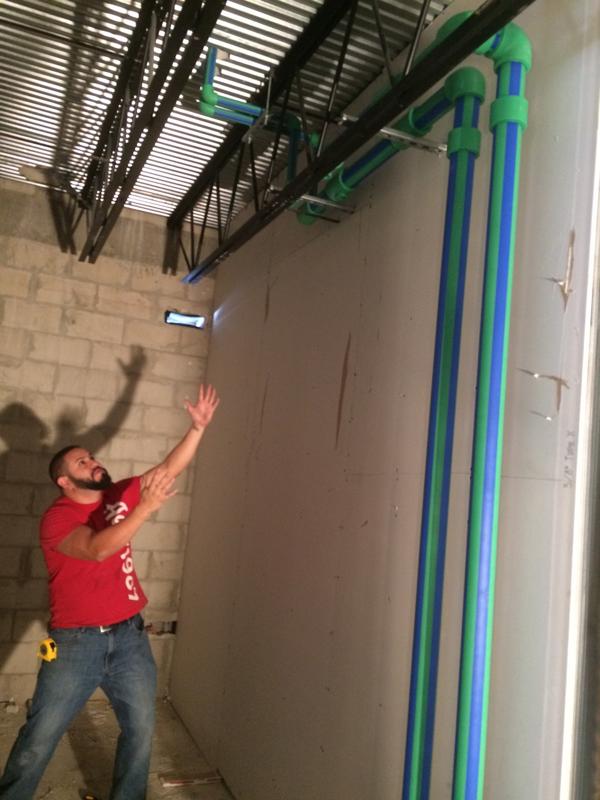 system. The system included a 25-ton air-cooled Trane chiller and an 8-ft tall, 8-ft diameter Calmac ice-storage tank to serve the cooling needs of the facility. A heat exchanger also was installed to separate the ice storage/glycol loop from the building’s chilled-water loop serving 11 air-handling units.
system. The system included a 25-ton air-cooled Trane chiller and an 8-ft tall, 8-ft diameter Calmac ice-storage tank to serve the cooling needs of the facility. A heat exchanger also was installed to separate the ice storage/glycol loop from the building’s chilled-water loop serving 11 air-handling units.
The TES system’s schedule is based on the time of year to take advantage of incentives from the utility company. For example, during the summer, electricity rates fall to non-peak prices around 9 p.m. At that time, while the building is not occupied, the chiller starts to build ice in the ice-storage tank. Then from 6 a.m. to noon when the building is occupied, the chiller operates normally to control the building’s air-conditioning needs while the utility rates are still off peak. From noon to 9 p.m., when electricity rates are at their peak, the chiller shuts down, the chilled water is pumped through the ice-storage tank and the ice contained in the ice tank is melted to condition the building.
FINDING THE RIGHT PIPING SYSTEM
To connect all of the large equipment and fabricate the glycol and chilled-water loops, Kazeminia and Smith needed just the right type of piping system. They originally specified steel, but it was cost-prohibitive and labor-intensive. They then spoke to their local distributor, who previously hosted a lunch-and-learn session for the engineers on aquatherm polypropylene-random (PP-R) piping systems. When the engineers discussed with the distributor their plan to install the piping themselves, the distributor suggested they try aquatherm SDR 11 blue®.
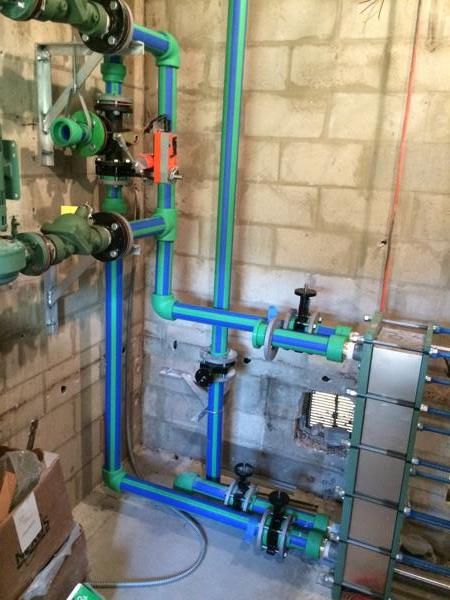 Created specifically to be a long-lasting solution for non-potable applications, such as heating and cooling and compressed air, blue won’t corrode or weaken over time. aquatherm’s blue has an optional multilayer faser (MF) layer that improves impact resistance and reduces linear expansion and contraction by about 75% compared with other plastics.
Created specifically to be a long-lasting solution for non-potable applications, such as heating and cooling and compressed air, blue won’t corrode or weaken over time. aquatherm’s blue has an optional multilayer faser (MF) layer that improves impact resistance and reduces linear expansion and contraction by about 75% compared with other plastics.
Additionally, because aquatherm pipe has a natural R-value of 1 depending on the pipe’s standard dimension ratio, for this application, Kazeminia and Smith were able to direct-bury the blue underground without extra insulation, helping minimize costs. Two-inch foam glass with an aluminum jacket was specified for the exterior above-ground piping. OCI Associates staff members confirmed that the heat loss in the un-insulated underground piping levels out to essentially zero shortly after the system begins operation.
A DO-IT-YOURSELF ATTITUDE
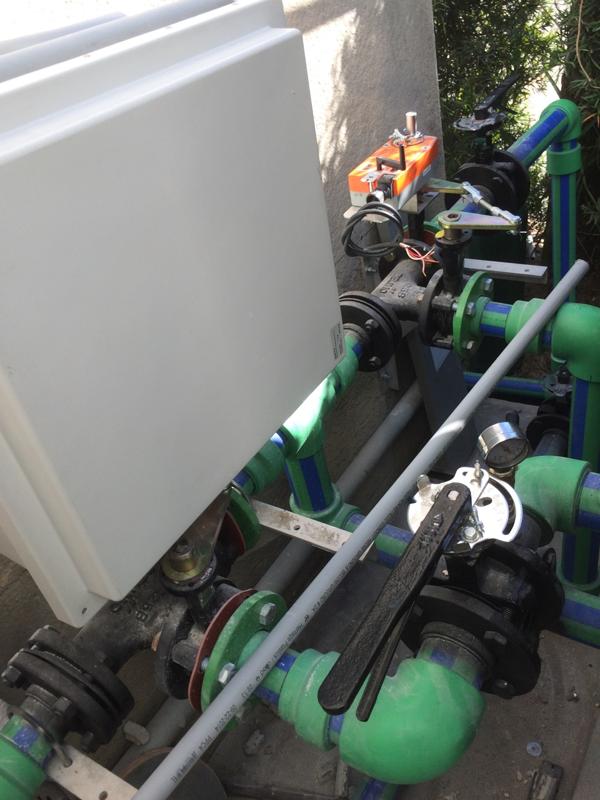 The distributor trained eight OCI Associates employees, including Kazeminia and Smith, on aquatherm’s heat-fusion technique. aquatherm piping uses reliable heat fusion to form connections; heat fusion bonds both sides of a joint into a single, homogenous material without the use of chemicals or mechanical connections, which eliminates systemic weaknesses and fail-points in the pipe. The seamless heat-fusion connections, combined with the piping’s resistance to corrosion and abrasion, help to ease leakage concerns.
The distributor trained eight OCI Associates employees, including Kazeminia and Smith, on aquatherm’s heat-fusion technique. aquatherm piping uses reliable heat fusion to form connections; heat fusion bonds both sides of a joint into a single, homogenous material without the use of chemicals or mechanical connections, which eliminates systemic weaknesses and fail-points in the pipe. The seamless heat-fusion connections, combined with the piping’s resistance to corrosion and abrasion, help to ease leakage concerns.
Because of time and space constraints, only one or two volunteers were working on the piping systems at any given time; they used McElroy socket irons and a Ritmo Prisma jig to install about 2,000 ft of Blue Pipe in sizes ranging from ¾ to 2½ in. on the project. All of the installers had “day jobs” at the engineering firm, so the majority of the work was done on weekends.
Although Smith estimates it took less than 30 working days to install the piping system, “a lot of that time spent or lost early in the installation was because we just had not done it before. You really have to plan ahead, and you can’t just run to Home Depot to get parts if you find out you are missing anything,” he said. “There was a bit of a learning curve, and we wanted to get the details correct.”
According to Smith, installation was easy once the installers got used to the pipe and equipment. “We have never done this before, obviously,” he said. “But the aquatherm is a lot more forgiving than other kinds of pipe. For a bunch of weekend warriors, it made our life easy. There was no way we would have been able to do what we did in the time we had with steel piping.”
MAKING THE GRADE
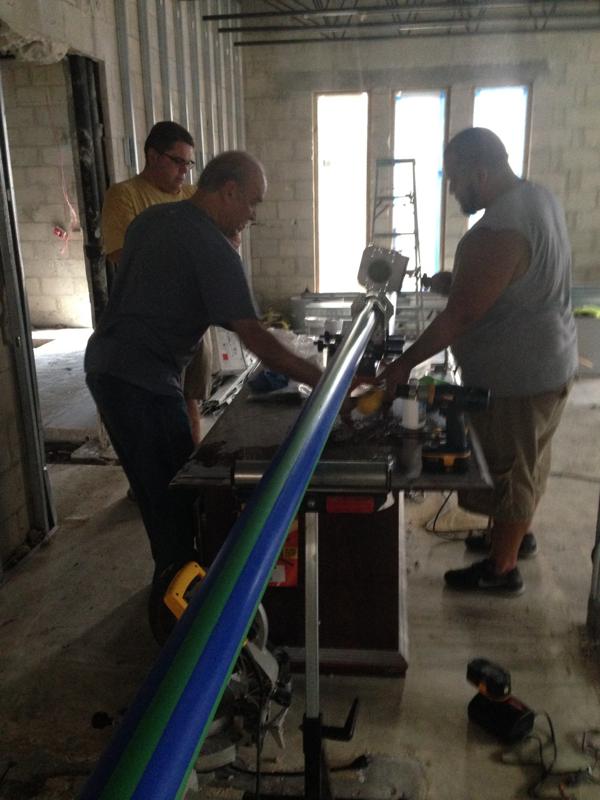
By installing the mechanical system themselves, the engineers were able to move into the renovated building on time and budget while maintaining their design intent. Based on the itemized bids they had received from several mechanical contractors, Smith estimates OCI Associates saved approximately $85,000 in material and labor costs.
“The most amazing thing about it was that we didn’t have a single failure in any of the aquatherm systems,” Smith said. “The only failures we had were with non-aquatherm fittings.”
The engineers are so pleased with the aquatherm PP-R piping that the firm already has specified the systems in other projects. Currently, OCI Associates is specifying aquatherm for an existing middle school that had a failed underground chilled-water piping system made from another type of thermoplastic.
“We actually have been pursuing all kinds of opportunities to utilize it.” Smith said. “We are confident in the product.”